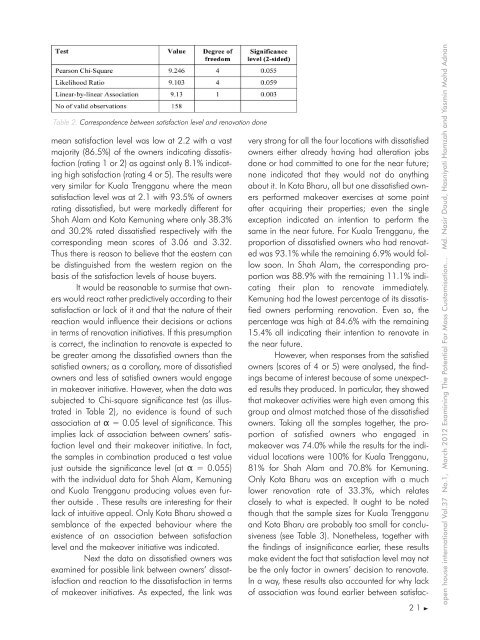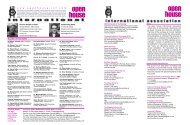Vol :37 Issue No.1 2012 - Open House International
Vol :37 Issue No.1 2012 - Open House International
Vol :37 Issue No.1 2012 - Open House International
Create successful ePaper yourself
Turn your PDF publications into a flip-book with our unique Google optimized e-Paper software.
Table 2. Correspondence between satisfaction level and renovation done<br />
mean satisfaction level was low at 2.2 with a vast<br />
majority (86.5%) of the owners indicating dissatisfaction<br />
(rating 1 or 2) as against only 8.1% indicating<br />
high satisfaction (rating 4 or 5). The results were<br />
very similar for Kuala Trengganu where the mean<br />
satisfaction level was at 2.1 with 93.5% of owners<br />
rating dissatisfied, but were markedly different for<br />
Shah Alam and Kota Kemuning where only 38.3%<br />
and 30.2% rated dissatisfied respectively with the<br />
corresponding mean scores of 3.06 and 3.32.<br />
Thus there is reason to believe that the eastern can<br />
be distinguished from the western region on the<br />
basis of the satisfaction levels of house buyers.<br />
It would be reasonable to surmise that owners<br />
would react rather predictively according to their<br />
satisfaction or lack of it and that the nature of their<br />
reaction would influence their decisions or actions<br />
in terms of renovation initiatives. If this presumption<br />
is correct, the inclination to renovate is expected to<br />
be greater among the dissatisfied owners than the<br />
satisfied owners; as a corollary, more of dissatisfied<br />
owners and less of satisfied owners would engage<br />
in makeover initiative. However, when the data was<br />
subjected to Chi-square significance test (as illustrated<br />
in Table 2), no evidence is found of such<br />
association at α = 0.05 level of significance. This<br />
implies lack of association between owners’ satisfaction<br />
level and their makeover initiative. In fact,<br />
the samples in combination produced a test value<br />
just outside the significance level (at α = 0.055)<br />
with the individual data for Shah Alam, Kemuning<br />
and Kuala Trengganu producing values even further<br />
outside . These results are interesting for their<br />
lack of intuitive appeal. Only Kota Bharu showed a<br />
semblance of the expected behaviour where the<br />
existence of an association between satisfaction<br />
level and the makeover initiative was indicated.<br />
Next the data on dissatisfied owners was<br />
examined for possible link between owners’ dissatisfaction<br />
and reaction to the dissatisfaction in terms<br />
of makeover initiatives. As expected, the link was<br />
very strong for all the four locations with dissatisfied<br />
owners either already having had alteration jobs<br />
done or had committed to one for the near future;<br />
none indicated that they would not do anything<br />
about it. In Kota Bharu, all but one dissatisfied owners<br />
performed makeover exercises at some point<br />
after acquiring their properties; even the single<br />
exception indicated an intention to perform the<br />
same in the near future. For Kuala Trengganu, the<br />
proportion of dissatisfied owners who had renovated<br />
was 93.1% while the remaining 6.9% would follow<br />
soon. In Shah Alam, the corresponding proportion<br />
was 88.9% with the remaining 11.1% indicating<br />
their plan to renovate immediately.<br />
Kemuning had the lowest percentage of its dissatisfied<br />
owners performing renovation. Even so, the<br />
percentage was high at 84.6% with the remaining<br />
15.4% all indicating their intention to renovate in<br />
the near future.<br />
However, when responses from the satisfied<br />
owners (scores of 4 or 5) were analysed, the findings<br />
became of interest because of some unexpected<br />
results they produced. In particular, they showed<br />
that makeover activities were high even among this<br />
group and almost matched those of the dissatisfied<br />
owners. Taking all the samples together, the proportion<br />
of satisfied owners who engaged in<br />
makeover was 74.0% while the results for the individual<br />
locations were 100% for Kuala Trengganu,<br />
81% for Shah Alam and 70.8% for Kemuning.<br />
Only Kota Bharu was an exception with a much<br />
lower renovation rate of 33.3%, which relates<br />
closely to what is expected. It ought to be noted<br />
though that the sample sizes for Kuala Trengganu<br />
and Kota Bharu are probably too small for conclusiveness<br />
(see Table 3). Nonetheless, together with<br />
the findings of insignificance earlier, these results<br />
make evident the fact that satisfaction level may not<br />
be the only factor in owners’ decision to renovate.<br />
In a way, these results also accounted for why lack<br />
of association was found earlier between satisfac-<br />
2 1<br />
open house international <strong>Vol</strong>.<strong>37</strong> <strong>No.1</strong>, March <strong>2012</strong> Examining The Potential For Mass Customisation... Md. Nasir Daud, Hasniyati Hamzah and Yasmin Mohd Adnan





